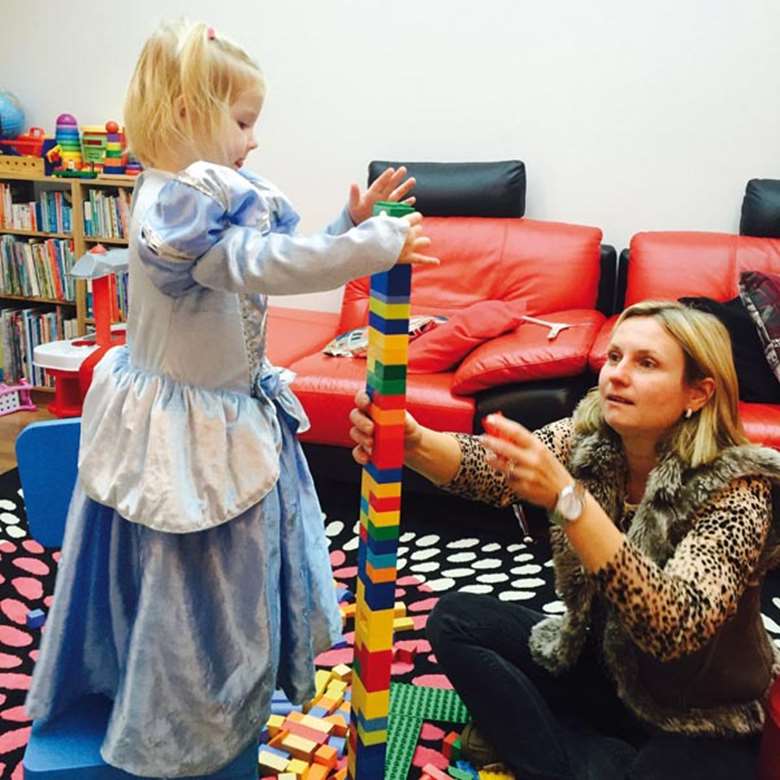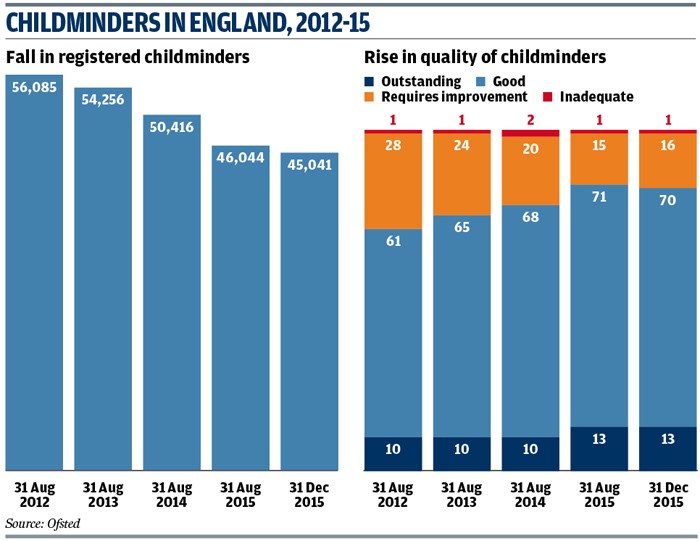Behind the Inspection Ratings: Childminder registrations
Jo Stephenson
Tuesday, May 24, 2016
At a time when the number of registered childminders in England has been steadily declining, quality of provision has been improving. So what complex factors lie behind these trends?

Latest Ofsted data shows that in the three months up to December 2015, the number of childminders fell by two per cent, continuing a trend that has seen a drop of more than 10,000 since 2012 (see graphic).
The factors behind the decline are complex, explains Liz Bayram, chief executive of the Professional Association for Childcare and Early Years.
One factor is how much the regulatory framework has changed over the past 10 years. “It has become more demanding, with a perception that it requires lots of paperwork and writing,” says Bayram, before adding that in reality it does not.
“Ofsted does not expect reams of paper to prove outcomes, but often it is perceived as that is what is needed.”
There was a drop in childminder numbers when the Early Years Foundation Stage was introduced in 2008 and revised in 2012, although the launch in September 2015 of the common inspection framework for early years and other education settings “hasn’t had such an impact because it is not a change to what’s required, but the way it is judged”, explains Bayram.
Ofsted also says there is “no evidence” to suggest the introduction of the new inspection regime “has had a particular impact on childminder numbers”.
Childminders need help to understand what is required of them, but in recent years the level of local authority support has diminished as a result of funding cuts.
“What we often hear from our childminder members is there is so much change – almost constant – and they just get fed up with that,” says Bayram. “At the very heart of this is a community of people generally working on their own who need support to manage this change and transition, yet what we know is over the years support at a local level is disappearing.”
Financial constraints also mean councils are doing less when it comes to actively recruiting childminders, so fewer people are joining the profession.
A major destabalising factor was the launch of childminder agencies by the Department for Education in 2013. Childminders feared they would be forced to sign up to an agency – which were introduced England-wide in September 2014 – although it is not compulsory and there are currently less than 10 in operation.
“There was a lot of confusion, uncertainty and anger,” says Bayram. “Even to this day, we see individual childminders who are concerned they’ll have to give up the one thing that matters to them – their self-employed autonomy.”
However, she adds agencies “haven’t made as big a splash as expected”. Ofsted has yet to inspect any of the handful set up so far.
“The government has asked Ofsted to inspect all childminder agencies within 12 months of them registering,” says a spokeswoman for Oftsed.
“Based on this request, we anticipate the first inspections will take place in the summer.”
Other factors contributing to the drop in childminder numbers include the rise of flexible and part-time working.
“Ten years ago, if you were an individual who wanted to balance work and home life it was very hard to find a role that allowed you to do that – childminding allowed you to do that,” says Bayram. “But what we have now is a myriad of other ways you can balance work and home life.”
Numbers may be falling but the quality of provision is improving, with a steady increase in the proportion of childminders rated “good” and “outstanding” by Ofsted (see graphic).
As of December 2015, there were 45,041 childminders. Of those, 83 per cent were rated “good” or “outstanding”, with 16 per cent given a “requires improvement” rating and just one per cent judged “inadequate”.
According to Ofsted, higher expectations of childminders have been a factor in this long-term trend. “Our Early Years Annual Report in 2015 and official statistical publications reveal this is partly due to weaker providers leaving the sector and childminders undergoing tougher registration processes, including compulsory training prior to registration,” says an Ofsted spokeswoman.
Research on childminder provision in England by the University of Oxford, published in September last year, identified key factors that drive quality.
These include high levels of early years training and support through a quality improvement programme or quality assurance scheme, such as the kind of help on offer in the London Borough of Bexley (see case study).
Childminders who were part of a quality improvement programme were much more likely to be “very good or above”, the study found.
Official data shows the number of childminders with qualifications at Early Years Educator Level 3 or above has increased.
Meanwhile, an increasing number of childminders are employing assistants. While the number of childminders decreased in the quarter from August 2015 to December 2015, the number of childminder places actually increased slightly by 0.2 per cent, or 581 extra places.
The total number of childminder assistantsis not known because Ofsted only records the minimum number. However, around 15,000 childminders work with “at least one” assistant.
Another development this year has seen a change in legislation that allows childminders to now spend half their time working in other settings, such as nurseries and schools, while remaining registered as a childminder.
“The classic model of a childminder working at home with his or her own children and some others is still there, but is not the whole picture anymore,” says Bayram.

Extra training boosts Bexley childminders
The London Borough of Bexley’s policy of investing in training and support for both new and existing childminders has paid dividends.
While the number of childminders has dropped in the last year, the borough has sufficient childminding places and is not actively recruiting at the moment, explains early years project officer Tracey Shaw.
Anyone interested in becoming a childminder receives support from the outset. They are sent an information pack about the process of becoming registered and advice on training providers.
When they have completed initial training, they are invited to a pre-registration briefing and, once registered, receive two home visits from the early years team.
The first provides a general introduction to services on offer in Bexley.
“Once they are minding, we visit for a second time to ensure everything is all right, check they are completing self-evaluation and iron out any hiccups,” says Shaw.
Each childminder is allocated a named officer from the team to be a main point of contact should they have any questions or concerns.
Childminders can sign up for a range of training via Bexley’s dedicated training website for education providers, which includes some fully-funded courses such as safeguarding and some part-funded courses. Other training is available for a small fee.
The team does not have a budget for training, so charges are ploughed back into the following year’s courses. These are delivered by Bexley’s in-house training team or external providers, explains Shaw, who is herself a trained childcare business adviser.
The training is shaped by feedback from childminders, who also have the chance to attend an annual conference.
This year’s event – Ensuring Quality in the Childminding Setting – was attended by about 90 childminders and featured workshops and talks on topics such as observation, early language skills and promoting British values.
The authority has a mix of childminders including relatively young people who were previously nannies or have left nurseries and pre-schools to set up their own business at home.
Shaw says the support Bexley provides is reflected in Ofsted inspection ratings.
“The amount of childminders coming through initially on their first inspection with ‘good’ and ‘outstanding’ is really high,” she says. “I can’t think of any new childminder that has gone below good.”
However, supporting existing childminders is “just as important” as helping new ones, she stresses. The authority runs a Moving to Good programme for those that have not achieved that rating.
Eleven childminders have just embarked on the second round of this course. Childminders on the first course have now all achieved a good rating.
Shaw says the slight decline in overall numbers is in part due to retirement, but also because some childminders with less than good ratings have decided to leave the profession.




